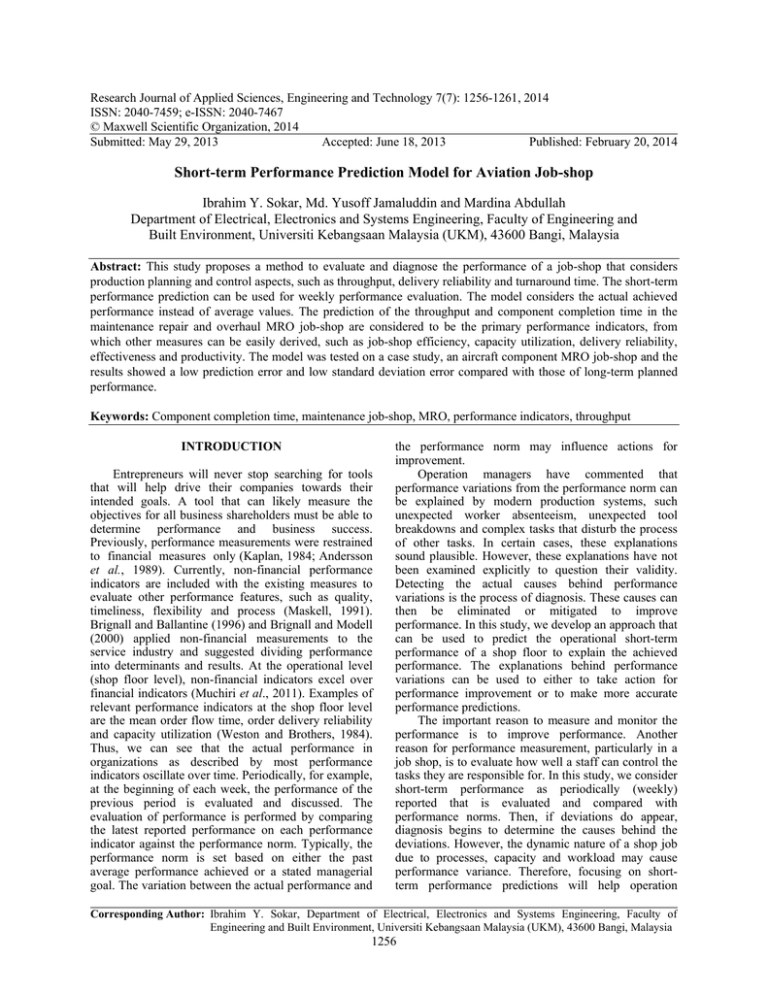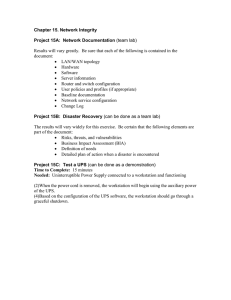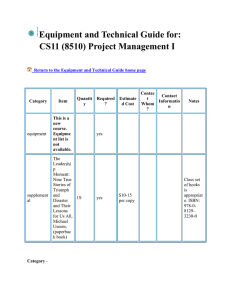Research Journal of Applied Sciences, Engineering and Technology 7(7): 1256-1261,... ISSN: 2040-7459; e-ISSN: 2040-7467
advertisement

Research Journal of Applied Sciences, Engineering and Technology 7(7): 1256-1261, 2014 ISSN: 2040-7459; e-ISSN: 2040-7467 © Maxwell Scientific Organization, 2014 Submitted: May 29, 2013 Accepted: June 18, 2013 Published: February 20, 2014 Short-term Performance Prediction Model for Aviation Job-shop Ibrahim Y. Sokar, Md. Yusoff Jamaluddin and Mardina Abdullah Department of Electrical, Electronics and Systems Engineering, Faculty of Engineering and Built Environment, Universiti Kebangsaan Malaysia (UKM), 43600 Bangi, Malaysia Abstract: This study proposes a method to evaluate and diagnose the performance of a job-shop that considers production planning and control aspects, such as throughput, delivery reliability and turnaround time. The short-term performance prediction can be used for weekly performance evaluation. The model considers the actual achieved performance instead of average values. The prediction of the throughput and component completion time in the maintenance repair and overhaul MRO job-shop are considered to be the primary performance indicators, from which other measures can be easily derived, such as job-shop efficiency, capacity utilization, delivery reliability, effectiveness and productivity. The model was tested on a case study, an aircraft component MRO job-shop and the results showed a low prediction error and low standard deviation error compared with those of long-term planned performance. Keywords: Component completion time, maintenance job-shop, MRO, performance indicators, throughput INTRODUCTION Entrepreneurs will never stop searching for tools that will help drive their companies towards their intended goals. A tool that can likely measure the objectives for all business shareholders must be able to determine performance and business success. Previously, performance measurements were restrained to financial measures only (Kaplan, 1984; Andersson et al., 1989). Currently, non-financial performance indicators are included with the existing measures to evaluate other performance features, such as quality, timeliness, flexibility and process (Maskell, 1991). Brignall and Ballantine (1996) and Brignall and Modell (2000) applied non-financial measurements to the service industry and suggested dividing performance into determinants and results. At the operational level (shop floor level), non-financial indicators excel over financial indicators (Muchiri et al., 2011). Examples of relevant performance indicators at the shop floor level are the mean order flow time, order delivery reliability and capacity utilization (Weston and Brothers, 1984). Thus, we can see that the actual performance in organizations as described by most performance indicators oscillate over time. Periodically, for example, at the beginning of each week, the performance of the previous period is evaluated and discussed. The evaluation of performance is performed by comparing the latest reported performance on each performance indicator against the performance norm. Typically, the performance norm is set based on either the past average performance achieved or a stated managerial goal. The variation between the actual performance and the performance norm may influence actions for improvement. Operation managers have commented that performance variations from the performance norm can be explained by modern production systems, such unexpected worker absenteeism, unexpected tool breakdowns and complex tasks that disturb the process of other tasks. In certain cases, these explanations sound plausible. However, these explanations have not been examined explicitly to question their validity. Detecting the actual causes behind performance variations is the process of diagnosis. These causes can then be eliminated or mitigated to improve performance. In this study, we develop an approach that can be used to predict the operational short-term performance of a shop floor to explain the achieved performance. The explanations behind performance variations can be used to either to take action for performance improvement or to make more accurate performance predictions. The important reason to measure and monitor the performance is to improve performance. Another reason for performance measurement, particularly in a job shop, is to evaluate how well a staff can control the tasks they are responsible for. In this study, we consider short-term performance as periodically (weekly) reported that is evaluated and compared with performance norms. Then, if deviations do appear, diagnosis begins to determine the causes behind the deviations. However, the dynamic nature of a shop job due to processes, capacity and workload may cause performance variance. Therefore, focusing on shortterm performance predictions will help operation Corresponding Author: Ibrahim Y. Sokar, Department of Electrical, Electronics and Systems Engineering, Faculty of Engineering and Built Environment, Universiti Kebangsaan Malaysia (UKM), 43600 Bangi, Malaysia 1256 Res. J. Appl. Sci. Eng. Technol., 7(7): 1256-1261, 2014 managers understand the short-term performance that can be achieved and these performance predictions will answer the ambiguous question of why there are deviations from the performance norm. Thus, a long discussion regarding the performance deviation can be avoided. It is important to manage all activities of maintenance operations, where activities can be managed by evaluating the performance of the process and efficiency of the maintenance crew involved. According to Neely et al. (2005) performance measurement is a process of quantifying the efficiency and effectiveness of an action. A framework was proposed by Aditya and Uday (2006) to measure the maintenance performance for internal and external effectiveness. However, Ivaturi et al. (1995) focused on evaluating and identifying strategies to improve crew maintenance team effectiveness in aviation maintenance operations. Zisis et al. (2009) showed the effect of measuring performance in service quality. Dietz and Rosenshine (1997) studied the structure of a maintenance workforce and optimized staff performance and cost. Oyetunji (2009) proposed a jobshop scheduling model to determine the number of maintenance technicians that need to be assigned to each center (Singh et al., 2010) measured the performance of different types of maintenance, preventive, proactive and aggressive and its effect on cost saving. More recently, Duer (2010) integrated an Artificial Neural Network (ANN) and expert knowledge-based systems to improve the efficiency of an aircraft maintenance crew. Aviation maintenance is unlike other types of maintenance due to its severity and strictness requirements. Even with the best located equipment, infrastructure tools, manpower and qualified maintenance crew to ensure that maintenance tasks are performed on time, there can still be deviations between the planned and actual achievement. Quan et al. (2007) studied the important schedules and the correlation between workforce and optimized maintenance time for preventive maintenance. However, for an aviation maintenance company to achieve world-class performance, much effort to improve quality and productivity is required and reduced costs. Short-term performance measures can be used as a control and diagnostic tool to provide direction and motivation toward achieving goals. This type of control tool is a form of single-loop feedback that is used to calculate the deviation from the standard performance norm and the ability to be corrected (Otley, 1999; Burney and Widener, 2007). DEFINITIONS Capacity: Typically, an MRO job-shop consists of several workstations, where each workstation consists of several machines and laborers. There are multiple aircraft components being processed in an MRO jobshop, which have different processing routes. The processing of different operations can be processed at different workstations. However, sometimes, the component or task can be processed by more than one laborer or machine. Therefore, the task must be assigned to an appropriate worker and machine to complete the task, which is called a production task assignment. The determination of labor (workforce) and machines in a workstation is called the production capacity. In fact, there are three scenarios of job-shop capacity, which are as follows: • • • Under capacity: Airline cannot satisfy its own demands of workforce and machines to perform MRO maintenance activity. Optimum capacity: In this scenario, the airline has a sufficient resource of workforce and machines to support its demand of MRO. Over capacity: There sources of the MRO are greater than what the airline requires due to reduction of flying hours, which will lower the number of maintenance activities. In this case, the airline offers their MRO capacity to the open market, which is a make and sell. Therefore, to improve the productivity and profitability of MRO job-shops, the available workforce must be used. Assumptions: The following are factors that influence a job-shop’s short-term performance measurements: Symbols Description m : The number of workstations in the jobshop : The actual work in process at workstation i 𝐼𝐼𝑖𝑖 (𝑛𝑛) at measurement period n : The available capacity at workstation i 𝐶𝐶𝑖𝑖 (𝑛𝑛) during measurement period n 𝑊𝑊𝑖𝑖 (𝑛𝑛) : The work assignment to workstation i during measurement period n : The amount of component scrap at 𝑆𝑆𝑖𝑖 (𝑛𝑛) workstation i during measurement period n : The collection of components at 𝑉𝑉𝑖𝑖,𝑗𝑗 workstation j with a higher priority than component i : The collection of components with a higher 𝑍𝑍𝑖𝑖,𝑗𝑗 priority than component i that is expected to arrive at workstation j within the next measurement period : The expected flow time of component i at 𝐹𝐹𝑖𝑖,𝑗𝑗 workstation j MW i, j : The minimal waiting time of component i at workstation j : The expected extra waiting time of 𝐸𝐸𝐸𝐸𝑖𝑖,𝑗𝑗 component i at workstation j : The processing time of component i at 𝑃𝑃𝑖𝑖,𝑗𝑗 workstation j The planned net available capacity of workstation i at the job-shop during measurement period n, measured 1257 Res. J. Appl. Sci. Eng. Technol., 7(7): 1256-1261, 2014 in hours, is denoted 𝐶𝐶𝑖𝑖̇ (𝑛𝑛). The planned net available capacity at workstation i is a function of both the net available operators capacity 𝑂𝑂̇𝑖𝑖 (𝑛𝑛) that is planned to be allocated and the planned net available tools capacity, denoted by 𝑇𝑇̇𝑖𝑖 (𝑛𝑛), both at workstation i during measurement period n and is measured in hours: 𝐶𝐶𝑖𝑖̇ (𝑛𝑛) = 𝑓𝑓﴾𝑂𝑂̇𝑖𝑖 (𝑛𝑛), 𝑇𝑇̇𝑖𝑖 (𝑛𝑛)﴿ (1) The planned amount of work assignment during measurement period n at workstation i of the job-shop is measured in hours and denoted as 𝑊𝑊̇𝑖𝑖 (𝑛𝑛). The plan for the work assignment of workstation i during measurement period n consists of new components that are expected to arrive for repair (external work assignment), 𝑊𝑊̇𝑖𝑖,ext (𝑛𝑛) and components expected to come from other workstations within the production path (the expected internal work assignment), 𝑊𝑊̇𝑖𝑖,int (𝑛𝑛). Therefore, the expected work assignment can be estimated using the list of all work in the process and the list of all components to be released next, where: 𝑊𝑊̇𝑖𝑖 (𝑛𝑛) = 𝑊𝑊̇𝑖𝑖,ext (𝑛𝑛) + 𝑊𝑊̇𝑖𝑖,int (𝑛𝑛) (2) The aforementioned factors refer to the workstation level. An aggregation of influencing factors for the total job-shop can be obtained through the summations of the values of all workstations and is as follows: The total work in process: ̇ 𝐼𝐼𝑠𝑠̇ (𝑛𝑛) = ∑𝑚𝑚 𝑖𝑖=1 𝐼𝐼𝑖𝑖 (𝑛𝑛) (3) ̇ 𝐶𝐶𝑠𝑠̇ (𝑛𝑛) = ∑𝑚𝑚 𝑖𝑖=1 𝐶𝐶𝑖𝑖 (𝑛𝑛) (4) ̇ 𝑊𝑊̇𝑠𝑠 (𝑛𝑛) = ∑𝑚𝑚 𝑖𝑖=1 𝑊𝑊𝑖𝑖 (𝑛𝑛) (5) ̇ 𝑆𝑆𝑠𝑠̇ (𝑛𝑛) = ∑𝑚𝑚 𝑖𝑖=1 𝑆𝑆𝑖𝑖 (𝑛𝑛) (6) The total capacity: is calculated by the level of work in process 𝐼𝐼𝑖𝑖 (𝑛𝑛), the expected work assignment and the expected capacity when the next period begins, as described in (4): 𝐼𝐼𝑖𝑖̇ (𝑛𝑛 + 1) = max �0, 𝐼𝐼𝑖𝑖 (𝑛𝑛) + 𝑊𝑊̇𝑖𝑖 (𝑡𝑡) − 𝐶𝐶𝑖𝑖̇ (𝑛𝑛)� (7) 𝑂𝑂̇𝑖𝑖 (𝑛𝑛) = min �𝑊𝑊̇𝑖𝑖 (𝑛𝑛), +𝐼𝐼𝑖𝑖 (𝑛𝑛), 𝐶𝐶𝑖𝑖̇ (𝑛𝑛) − 𝑆𝑆𝑖𝑖̇ (𝑛𝑛)� (8) ̇ 𝑂𝑂̇𝑖𝑖 (𝑛𝑛) = ∑𝑚𝑚 𝑖𝑖=1 𝑂𝑂𝑖𝑖 (𝑛𝑛) (9) The prediction output 𝑂𝑂̇𝑖𝑖 (𝑛𝑛) for measurement period n at workstation i measured in hours is determined by the actual work in process, 𝐼𝐼𝑖𝑖̇ (𝑛𝑛), the expected available capacity 𝐶𝐶𝑖𝑖̇ (𝑛𝑛) and expected work assignment 𝑊𝑊̇𝑖𝑖 (𝑛𝑛), Analogous to the aggregation of the work in process, the available capacity and work assignment from workstation level to production path level (job-shop level), the prediction output (hours) 𝑂𝑂̇𝑖𝑖 (𝑛𝑛) of the job-shop are considered as one of the main performance indicators, where the prediction output for a certain measurement period can be calculated by (5): The job-shop expected output 𝑂𝑂̇𝑖𝑖 (𝑛𝑛) can be obtained by totalling the expected output of the m individual workstations in the production path by: Completion time: The estimation of the component completion time Turnaround Time (TAT) will be directed at individual components. To determine the components completion time, the processing time of the component at the current workstation and the expected flow time at the remaining workstations in the routing of the component are considered. The processing time of the component at the current workstation can be described by Eq. (10): The total work assignment: For, 𝐹𝐹𝑖𝑖,𝑗𝑗 = 𝑀𝑀𝑀𝑀𝑖𝑖,𝑗𝑗 + 𝐸𝐸𝐸𝐸𝑖𝑖,𝑗𝑗 + 𝑃𝑃𝑖𝑖,𝑗𝑗 (10) 𝑀𝑀𝑀𝑀𝑖𝑖,𝑗𝑗 = ∑𝑥𝑥∈𝑉𝑉𝑖𝑖𝑖𝑖 𝑃𝑃𝑥𝑥,𝑗𝑗 ; 𝑎𝑎𝑎𝑎𝑎𝑎𝐸𝐸𝐸𝐸𝑖𝑖,𝑗𝑗 = ∑𝑥𝑥∈𝑍𝑍𝑖𝑖𝑖𝑖 𝑃𝑃𝑦𝑦,𝑗𝑗 (11) The total component scrap: The estimated available capacity 𝐶𝐶𝑖𝑖̇ (𝑛𝑛), work assignment 𝑊𝑊̇𝑖𝑖 (𝑛𝑛), component scrap 𝑆𝑆𝑖𝑖̇ (𝑛𝑛) and estimated work in process 𝐼𝐼𝑖𝑖̇ (𝑛𝑛) are used, where m is the total number of workstations in a job-shop and i denotes the workstation number. SHORT-TERM PREDICTION PERFORMANCE INDICATORS Prediction output: The expected work in process at a workstation for the next measurement period 𝐼𝐼𝑖𝑖̇ (𝑛𝑛 + 1) 𝑍𝑍𝑖𝑖,𝑗𝑗 is determined by considering each workstation except workstation j; the estimation is performed by considering which component will be processed at the workstation and is based on a study by Rupp et al. (2000). An MRO job-shop should first repair the components that have a high probability of being in immediate demand. The number of failures of a component can be described by a Poisson distribution. The quantity of spare parts of a component c is denoted by SPQc. These spare components are owned by the MRO job shop and can be exchanged during repair or overhauling. All variables are assumed to refer to a specific component if not stated otherwise. 1258 Res. J. Appl. Sci. Eng. Technol., 7(7): 1256-1261, 2014 If a component is faulty in a Bernoulli experiment with a very small probability of failure (p→0), then it is well known that if such an experiment is conducted repeatedly (n→∞), then the sum of the Bernoullidistributed stochastic variables converges to a Poisson distribution with parameter λ = n.p, or as stated by (Bartoszynski and Niewiadomska-Bugaj, 2007): 𝑛𝑛 𝜆𝜆 𝑘𝑘 lim𝑛𝑛→∞ � � 𝑝𝑝𝑘𝑘 (1 − 𝑝𝑝)𝑛𝑛−𝑘𝑘 = 𝑒𝑒 −𝜆𝜆 𝑘𝑘! 𝑘𝑘 (12) where, the left-hand side is the binomial probability of k successes in n trials (Bartoszynski and NiewiadomskaBugaj, 2007). Note that the probability follows that the time between two failures is independently and exponentially distributed (Bartoszynski and Niewiadomska-Bugaj, 2007). As a consequence of the number of failures, the number of demands within the Turnaround Time (TAT) is Poisson distributed, where the turnaround time is the repair time of a component at the job-shop. The parameter λ of the Poisson distribution is its mean and also its variance. Hence, if we know the demand per day d c of a component c and the length t c of the TAT interval, we can calculate the probability P (λ, n) that n demands occur during the TAT interval in the following way: 𝑃𝑃(𝜆𝜆, 𝑛𝑛) = ∑𝑛𝑛𝑖𝑖=0 = ∑𝑛𝑛𝑖𝑖=0 𝜆𝜆 𝑖𝑖 𝑖𝑖! exp−𝜆𝜆 (𝑑𝑑 𝑐𝑐 .𝑡𝑡 𝑐𝑐 )𝑖𝑖 𝑖𝑖! exp−𝑑𝑑 𝑐𝑐 .𝑡𝑡𝑐𝑐 (13) Eventually, it can be determined which selected component has the higher priority than component i. Thus, by calculating the expected flow time at the first workstation in the remaining workstation routing, we can now predict the expected flow time of the remaining workstations to which the component will be routed. However, the expected waiting time at other workstations can be approximated by the amount of work still in the process at these workstations at the time when this component arrives. By doing so, the flow time of the second workstation k can be expected for the routing of component i by (14): 𝐹𝐹𝑖𝑖,𝑘𝑘 = 𝐼𝐼𝑘𝑘̇ �𝐹𝐹𝑖𝑖,𝑗𝑗 � + 𝑃𝑃𝑖𝑖,𝑘𝑘 (14) Thus, from the above two indicators, the predicted output (hours) and the predicted component completion time of the job-shop, which considers other main performance indicators, such as capacity utilization, delivery reliability, job-shop efficiency, effectiveness and productivity, can be easily derived from these two measures. Case study: The organization considered in the case study is one of the largest MRO service providers in the Asia-Pacific region. The organization, which was established in 1972, has over 36 years of experience in the MRO business, delivering a comprehensive range of services for aircrafts, such as the F50, B737 Classic and Table 1: Example of data obtained from 9 production units in the MRO job-shop Work station no. Work in process Expected capacity Actual capacity 1 490 549 544 2 639 653 710 3 167 172 186 4 294 368 327 5 185 204 205 6 431 510 479 7 306 360 351 8 144 168 160 9 156 177 173 Total Table 2: Examples of the prediction quality of the predicted throughput Weeks Actual throughput Planned throughput 25 2763 3097 26 2746 2900 27 2473 2423 28 2509 2600 29 2492 2592 30 2400 2500 31 2460 2722 32 2269 2188 33 2500 2600 34 1989 1960 35 1729 1920 36 1690 1820 37 2000 1850 38 2200 2100 39 1980 2005 40 2770 2611 41 3060 3211 42 2662 2700 Total 1259 Std. 236.1730 108.8940 35.3553 64.3467 70.7107 70.7107 185.2620 57.2756 70.7107 20.5061 135.0570 91.9239 106.0660 70.7107 17.6777 112.4300 106.7730 26.8701 1587.4550 Planned throughput 517 697 186 326 205 479 351 158 178 3097 Actual throughput 451 537 212 326 161 437 351 148 140 2763 Predicted throughput 2931 2892 2411 2530 2500 2420 2610 2198 2489 2000 1800 1800 1900 2240 2001 2612 3000 2672 Std. 118.793 103.237 43.840 14.849 5.656 14.142 106.066 50.204 7.778 7.778 50.204 77.781 70.710 28.284 14.849 111.722 42.426 7.071 875.398 Res. J. Appl. Sci. Eng. Technol., 7(7): 1256-1261, 2014 REFERENCES Fig. 1: Actual, planned and predicted throughput for 18 weeks B747 series, the A330 and A320 families and the B777 and is currently supporting MRO services for more than 100 airlines. The data were taken form 9 random workstations. Each production unit works 8-h shifts, five days a week, where Table 1 shows the data for 18 weeks. Occasionally, overtime is required to reduce production order backlogs. To show the quality of the predictions of throughput, the prediction errors for all production orders that were completed in the production units were determined by taking the difference between the predicted throughput and the actual throughput. For each production unit, the averages and standard deviations of the prediction errors over 18 weeks are shown in Table 2. It can be observed that the predicted throughput in production units on average is more accurate than the planned performance, with only a small error between the actual performances. As can also be observed from Fig. 1, the prediction model follows, on average, the fluctuations with the actual performance extremely well. CONCLUSION In this study, a method to evaluate and predict short-term performance for an MRO job-shop is described. This model is used to predict the accuracy of the planned performance of the job-shop and also to predict what performance can be achieved. The purpose of the performance prediction model is to provide realistic information of the state of a production unit. The model helps management of the shop floor to improve their performance by taking into account the actual state of the job-shop and the expected input. The prediction model provides the basis for discussions between the people involved to determine how work should be organized to realize the performance targets. This model was implemented and tested on an actual job-shop and the results were impressive, showing a small range in standard deviation and error rate between the predicted result and the actual achievement compared with the planned performance. Aditya, P. and K. Uday, 2006. Maintenance Performance Measurement (MPM): Issues and challenges. J. Qual. Maint. Eng., 12(3): 239-251. Andersson, P., H. Aronsson and N.G. Storhagen, 1989. Measuring logistics performance. Eng. Cost. Prod. Econ., 17(1): 253-262. Bartoszynski, R. and M. Niewiadomska-Bugaj, 2007. Probability and Statistical Inference. WileyInterscience, John Wiley & Sons, Hoboken, N.J., pp: 672, ISBN: 0470191589. Brignall, S. and J. Ballantine, 1996. Performance measurement in service businesses revisited. Int. J. Serv. Ind. Manag., 7(1): 6-31. Brignall, S. and S. Modell, 2000. An institutional perspective on performance measurement and management in the ‘new public sector. Manage. Account. Res., 11(3): 281-306. Burney, L. and S.K. Widener, 2007. Strategic performance measurement systems, job-relevant information and managerial behavioral responsesrole stress and performance. Behav. Res. Account., 19(1): 43-69. Dietz, D.C. and M. Rosenshine, 1997. Optimal specialization of a maintenance workforce. IIE Trans., 29(5): 423-433. Duer, S., 2010. Expert knowledge base to support maintenance of a radar system. Defence Sci. J., 60(5). Ivaturi, S., A.K. Gramopadhye, D. Kraus and R. Blackmon, 1995. Team training to improve the effectiveness of teams in the aircraft maintenance environment. Hum. Fac. Erg. Soc. P., 39(20): 1355-1359. Kaplan, R.S., 1984. The evolution of management accounting. Account. Rev., 59(3): 390-418. Maskell, B.H., 1991. Performance Measurement for World Class Manufacturing: A Model for American Companies. Productivity Press, Cambridge, Mass, pp: 408. Muchiri, P., L. Pintelon, L. Gelders and H. Martin, 2011. Development of maintenance function performance measurement framework and indicators. Int. J. Prod. Econ., 131(1): 295-302. Neely, A., M. Gregory and K. Platts, 2005. Performance measurement system design: A literature review and research agenda. Int. J. Oper. Prod. Man., 25(12): 1228-1263. Otley, D., 1999. Performance management: A framework for management control systems research. Manage. Account. Res., 10(4): 363-382. Oyetunji, E., 2009. Some common performance measures in scheduling problems: Review article. Res. J. Appl. Sci. Eng. Technol., 1(2): 6-9. Quan, G., G.W. Greenwood, D. Liu and S. Hu, 2007. Searching for multiobjective preventive maintenance schedules: Combining preferences with evolutionary algorithms. Eur. J. Oper. Res., 177(3): 1969-1984. 1260 Res. J. Appl. Sci. Eng. Technol., 7(7): 1256-1261, 2014 Rupp, B., D. Pauli, S. Feller and M. Skyttä, 2000. Workshop Scheduling in the MRO Context. Proceeding of the International Conference of Numerical Analysis and Applied Mathematics, September 19-25, pp: 2010. Singh, R.K., S.K. Garg and S. Deshmukh, 2010. Strategy development by small scale industries in India. Ind. Manage. Data Syst., 110(7): 1073-1093. Weston, F. and W. Brothers, 1984. Productivity management by the numbers. Prod. Invent. Manage., 25(3): 54-67. Zisis, P., A. Garefalakis and N. Sariannidis, 2009. The Application of Performance Measurement in the Service Quality Concept: The Case of a Greek Service Organization. Available at SSRN 1359926, Retrieved from: http://papers. ssrn. com/ sol3/ papers. cfm? Abstract_id = 1359926. 1261




